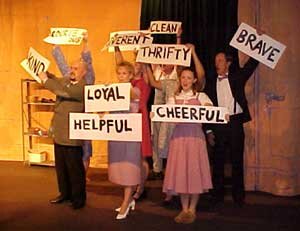Shameless Self-Promotion: Figaro!
/Count Almaviva discovers Cherubino where he shouldn’t be.
When I began this “Shameless Self-Promotion” series of blogposts, I had a short list of works that I thought could use some exposure. It was a very short list. Today’s post was to be the last, just sort of a grab bag of a couple of musical compositions you might like.
And then, this morning, as I was performing my toilette, I realized I had overlooked quite a major work: Mozart’s Marriage of Figaro.
You see, way back in 2002, I was retiring from the position of artistic director of the (then-named) Newnan Community Theatre Company, and I decided as we planned that last season that my final production as a director would be Le Nozze di Figaro, my favorite — and the funniest — 18th-c. comic opera.
Figaro confers with Marcellina and Barberina in Act IV of “Mozart’s Marriage of Figaro.”
I was not a crackpot. Once or twice a season we’d have these one-night performances called “The Reading,” in which members of the company would take texts (liberally interpreted) that were not written for performance and turn them into performances. We had things like:
“The Raven” as performed by Shirley Temple
Pilliard Dickle’s infamous “Nun Song”
Donne’s seductive “To His Mistress Going to Bed” ending with the speaker (in full tux) slyly loosening his bowtie
the opening chapter of Perfume performed by a company member with no sense of smell, who took odoriferous items from the table before her and tossed them into a garbage can, out of which she pulled a doll to announce the birth of the protagonist.
That kind of thing. Some silliness, some profundity, easy to stage, and it stretched our performance muscles.
All of which is to say that at a Reading in 1999 or so, we did a performance of a 10-minute musical I wrote based on a beloved children’s book — the copyright issues of which forbid me to name here — and I cribbed the ending of it from the Act II finale of Figaro. Much like A Christmas Carol twenty years before, members of the company convinced me that I should drag them all into a 3-hour 18th-c. opera.
So I spent a year or so translating da Ponte’s libretto. I do not speak Italian, but I was super familiar with the text, plus the Schirmer score had a German version beneath the original, and I speak enough German to use it as a tool.
Figaro leads a chorus of servants in a pæan to Count Almaviva.
My goal was simple: produce a text that was 1) singable; 2) entertaining; and 3) recognizable to an “amateur” audience as musical comedy. I tried to keep the same rhyme schemes (not an easy thing in English), and I made absolutely sure that where a character’s name appeared in the original, it appeared in my translation. I structured punchlines and threw in a few gags of my own.
And we did it. We had a few operatically trained voices, but mostly we were Broadway showtune singers, and it worked. We rehearsed and performed it as a musical comedy, audiences were enthralled, and the run was sold out.
Let me repeat that: In Newnan, GA, we sold out a three-weekend run of an opera. Audiences enjoyed the hell out of it, and one of our season ticket patrons who was an actual opera buff said it was one of the few productions of Nozze that actually captured the joyous, chaotic spirit of the original.
So if you have some reasonably trained singers at your disposal, I highly recommend Mozart’s Marriage of Figaro as an experience, both for you and for your audience. You can find it here. (Yes, the webpage uses frames. It was the turn of the century. Leave me alone.)





